Finance Report: Comprehensive Analysis of Auriel's Trail Balance
VerifiedAdded on 2020/12/10
|8
|1938
|307
Report
AI Summary
This finance report provides a comprehensive analysis of Auriel's trail balance, a crucial aspect of financial management. It begins with an introduction to finance and its importance in organizational operations, followed by an assessment of the trail balance's sources and structure, emphasizing the double-entry bookkeeping system and the use of manual and computerized methods. The report then delves into various adjustments made to the trail balance, including those related to stock valuation, insurance, depreciation of office furniture, bad debts, and outstanding salaries. Furthermore, it effectively explains accruals and prepayments, detailing their impact on financial statements. The report also explains depreciation and provision for doubtful debts. Finally, it concludes by summarizing the key findings and referencing relevant sources. The report offers a detailed overview of financial concepts and their application in real-world scenarios.

Finance
(PART B)
(PART B)
Paraphrase This Document
Need a fresh take? Get an instant paraphrase of this document with our AI Paraphraser
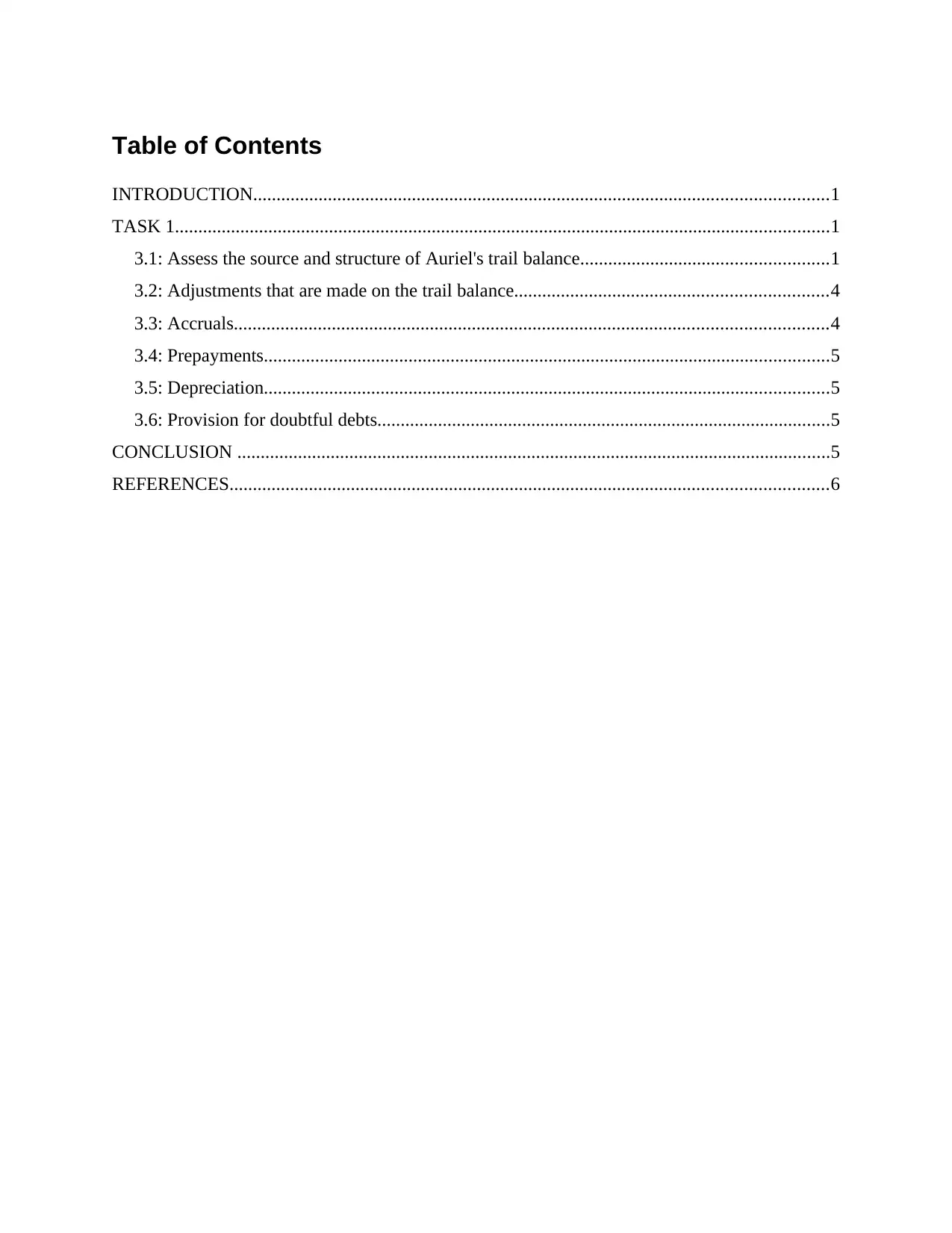
Table of Contents
INTRODUCTION...........................................................................................................................1
TASK 1............................................................................................................................................1
3.1: Assess the source and structure of Auriel's trail balance.....................................................1
3.2: Adjustments that are made on the trail balance...................................................................4
3.3: Accruals...............................................................................................................................4
3.4: Prepayments.........................................................................................................................5
3.5: Depreciation.........................................................................................................................5
3.6: Provision for doubtful debts.................................................................................................5
CONCLUSION ...............................................................................................................................5
REFERENCES................................................................................................................................6
INTRODUCTION...........................................................................................................................1
TASK 1............................................................................................................................................1
3.1: Assess the source and structure of Auriel's trail balance.....................................................1
3.2: Adjustments that are made on the trail balance...................................................................4
3.3: Accruals...............................................................................................................................4
3.4: Prepayments.........................................................................................................................5
3.5: Depreciation.........................................................................................................................5
3.6: Provision for doubtful debts.................................................................................................5
CONCLUSION ...............................................................................................................................5
REFERENCES................................................................................................................................6
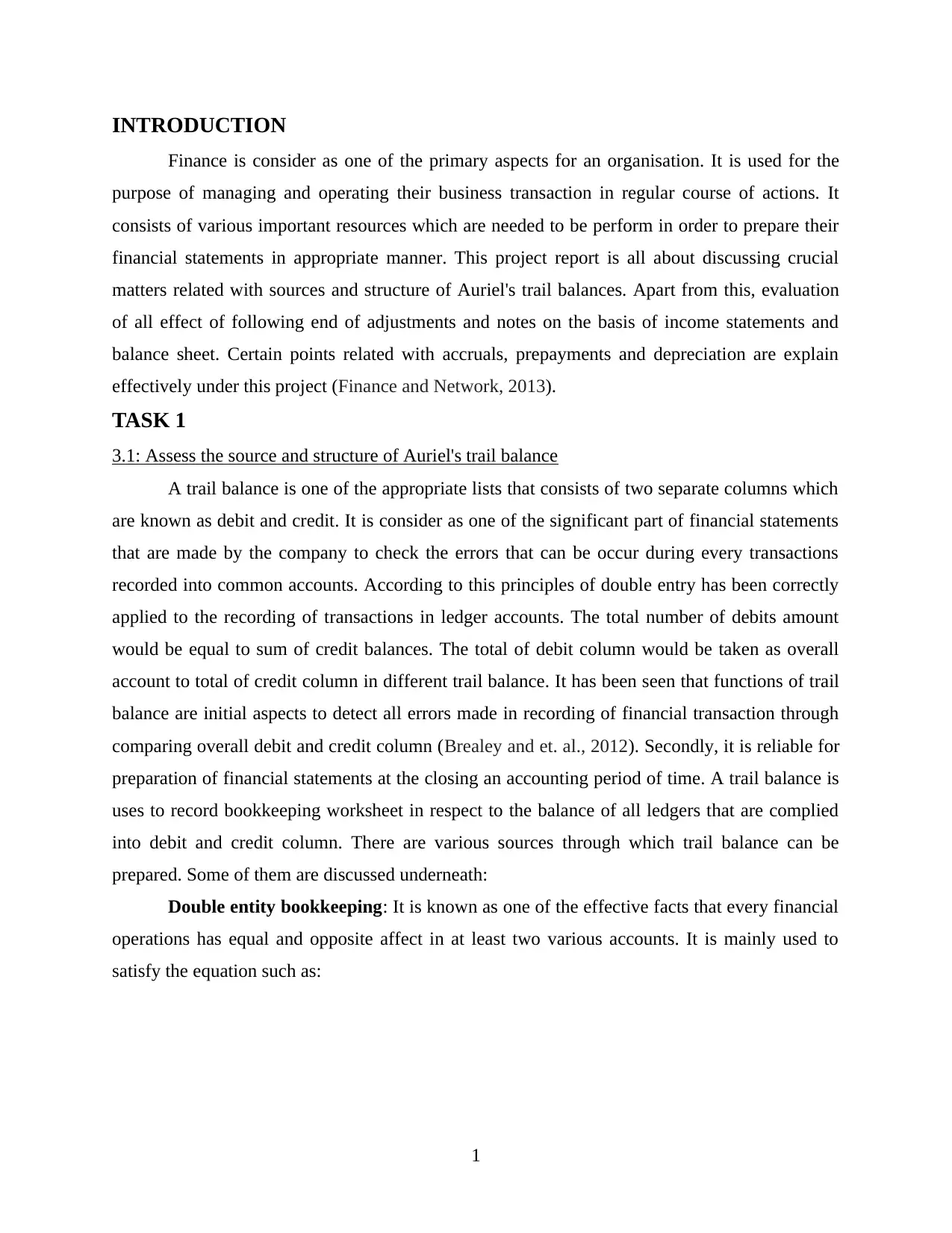
INTRODUCTION
Finance is consider as one of the primary aspects for an organisation. It is used for the
purpose of managing and operating their business transaction in regular course of actions. It
consists of various important resources which are needed to be perform in order to prepare their
financial statements in appropriate manner. This project report is all about discussing crucial
matters related with sources and structure of Auriel's trail balances. Apart from this, evaluation
of all effect of following end of adjustments and notes on the basis of income statements and
balance sheet. Certain points related with accruals, prepayments and depreciation are explain
effectively under this project (Finance and Network, 2013).
TASK 1
3.1: Assess the source and structure of Auriel's trail balance
A trail balance is one of the appropriate lists that consists of two separate columns which
are known as debit and credit. It is consider as one of the significant part of financial statements
that are made by the company to check the errors that can be occur during every transactions
recorded into common accounts. According to this principles of double entry has been correctly
applied to the recording of transactions in ledger accounts. The total number of debits amount
would be equal to sum of credit balances. The total of debit column would be taken as overall
account to total of credit column in different trail balance. It has been seen that functions of trail
balance are initial aspects to detect all errors made in recording of financial transaction through
comparing overall debit and credit column (Brealey and et. al., 2012). Secondly, it is reliable for
preparation of financial statements at the closing an accounting period of time. A trail balance is
uses to record bookkeeping worksheet in respect to the balance of all ledgers that are complied
into debit and credit column. There are various sources through which trail balance can be
prepared. Some of them are discussed underneath:
Double entity bookkeeping: It is known as one of the effective facts that every financial
operations has equal and opposite affect in at least two various accounts. It is mainly used to
satisfy the equation such as:
1
Finance is consider as one of the primary aspects for an organisation. It is used for the
purpose of managing and operating their business transaction in regular course of actions. It
consists of various important resources which are needed to be perform in order to prepare their
financial statements in appropriate manner. This project report is all about discussing crucial
matters related with sources and structure of Auriel's trail balances. Apart from this, evaluation
of all effect of following end of adjustments and notes on the basis of income statements and
balance sheet. Certain points related with accruals, prepayments and depreciation are explain
effectively under this project (Finance and Network, 2013).
TASK 1
3.1: Assess the source and structure of Auriel's trail balance
A trail balance is one of the appropriate lists that consists of two separate columns which
are known as debit and credit. It is consider as one of the significant part of financial statements
that are made by the company to check the errors that can be occur during every transactions
recorded into common accounts. According to this principles of double entry has been correctly
applied to the recording of transactions in ledger accounts. The total number of debits amount
would be equal to sum of credit balances. The total of debit column would be taken as overall
account to total of credit column in different trail balance. It has been seen that functions of trail
balance are initial aspects to detect all errors made in recording of financial transaction through
comparing overall debit and credit column (Brealey and et. al., 2012). Secondly, it is reliable for
preparation of financial statements at the closing an accounting period of time. A trail balance is
uses to record bookkeeping worksheet in respect to the balance of all ledgers that are complied
into debit and credit column. There are various sources through which trail balance can be
prepared. Some of them are discussed underneath:
Double entity bookkeeping: It is known as one of the effective facts that every financial
operations has equal and opposite affect in at least two various accounts. It is mainly used to
satisfy the equation such as:
1
⊘ This is a preview!⊘
Do you want full access?
Subscribe today to unlock all pages.

Trusted by 1+ million students worldwide
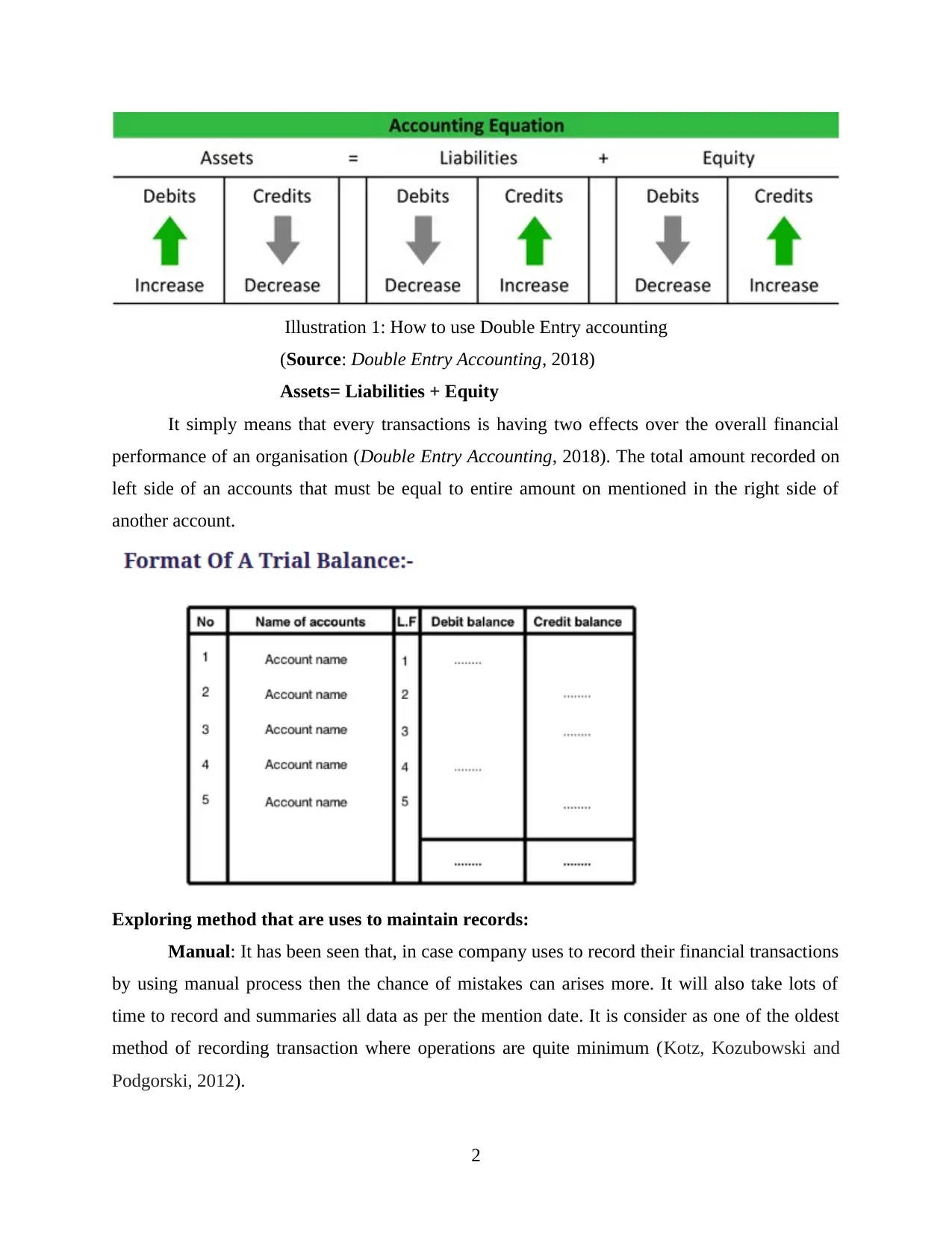
Illustration 1: How to use Double Entry accounting
(Source: Double Entry Accounting, 2018)
Assets= Liabilities + Equity
It simply means that every transactions is having two effects over the overall financial
performance of an organisation (Double Entry Accounting, 2018). The total amount recorded on
left side of an accounts that must be equal to entire amount on mentioned in the right side of
another account.
Exploring method that are uses to maintain records:
Manual: It has been seen that, in case company uses to record their financial transactions
by using manual process then the chance of mistakes can arises more. It will also take lots of
time to record and summaries all data as per the mention date. It is consider as one of the oldest
method of recording transaction where operations are quite minimum (Kotz, Kozubowski and
Podgorski, 2012).
2
(Source: Double Entry Accounting, 2018)
Assets= Liabilities + Equity
It simply means that every transactions is having two effects over the overall financial
performance of an organisation (Double Entry Accounting, 2018). The total amount recorded on
left side of an accounts that must be equal to entire amount on mentioned in the right side of
another account.
Exploring method that are uses to maintain records:
Manual: It has been seen that, in case company uses to record their financial transactions
by using manual process then the chance of mistakes can arises more. It will also take lots of
time to record and summaries all data as per the mention date. It is consider as one of the oldest
method of recording transaction where operations are quite minimum (Kotz, Kozubowski and
Podgorski, 2012).
2
Paraphrase This Document
Need a fresh take? Get an instant paraphrase of this document with our AI Paraphraser
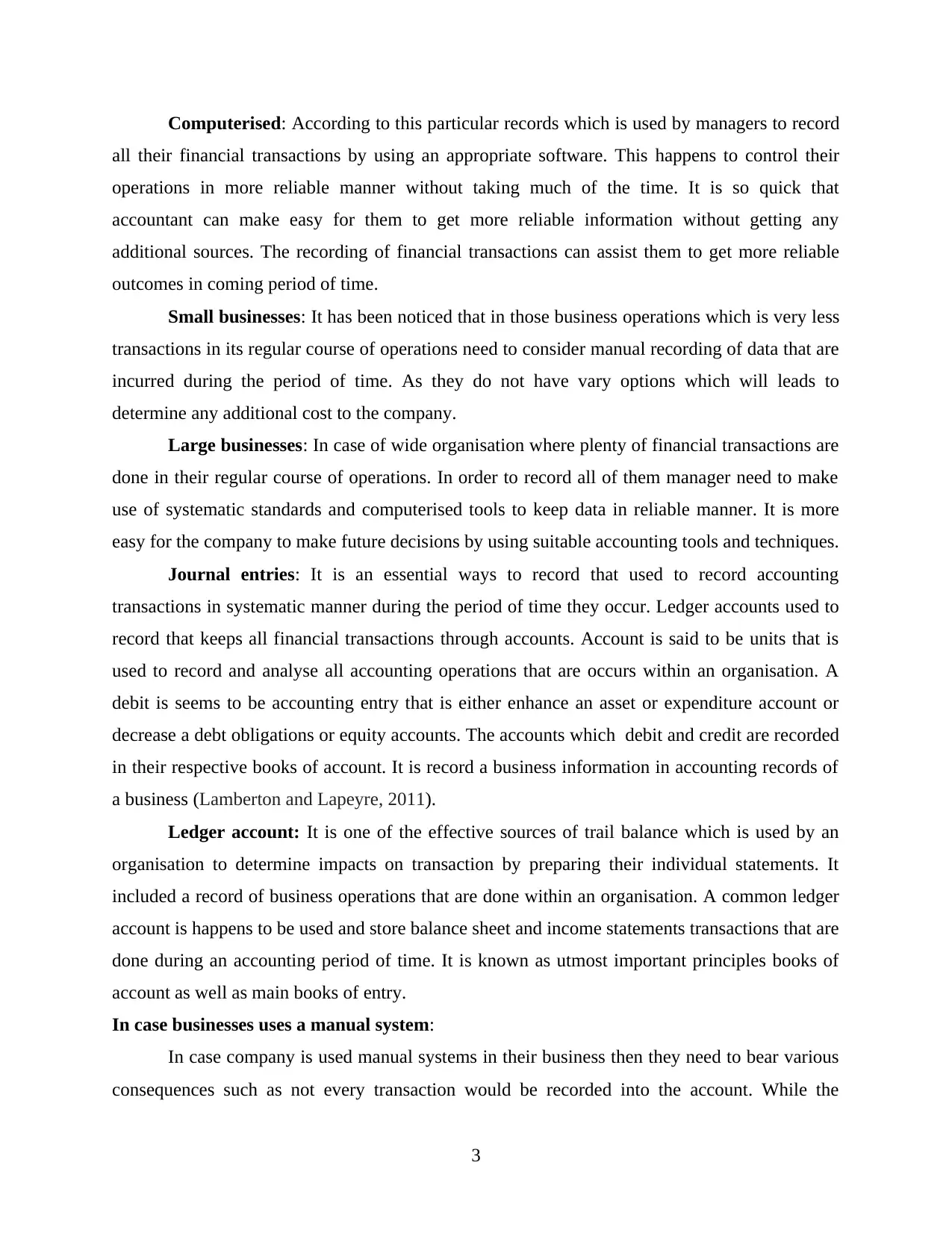
Computerised: According to this particular records which is used by managers to record
all their financial transactions by using an appropriate software. This happens to control their
operations in more reliable manner without taking much of the time. It is so quick that
accountant can make easy for them to get more reliable information without getting any
additional sources. The recording of financial transactions can assist them to get more reliable
outcomes in coming period of time.
Small businesses: It has been noticed that in those business operations which is very less
transactions in its regular course of operations need to consider manual recording of data that are
incurred during the period of time. As they do not have vary options which will leads to
determine any additional cost to the company.
Large businesses: In case of wide organisation where plenty of financial transactions are
done in their regular course of operations. In order to record all of them manager need to make
use of systematic standards and computerised tools to keep data in reliable manner. It is more
easy for the company to make future decisions by using suitable accounting tools and techniques.
Journal entries: It is an essential ways to record that used to record accounting
transactions in systematic manner during the period of time they occur. Ledger accounts used to
record that keeps all financial transactions through accounts. Account is said to be units that is
used to record and analyse all accounting operations that are occurs within an organisation. A
debit is seems to be accounting entry that is either enhance an asset or expenditure account or
decrease a debt obligations or equity accounts. The accounts which debit and credit are recorded
in their respective books of account. It is record a business information in accounting records of
a business (Lamberton and Lapeyre, 2011).
Ledger account: It is one of the effective sources of trail balance which is used by an
organisation to determine impacts on transaction by preparing their individual statements. It
included a record of business operations that are done within an organisation. A common ledger
account is happens to be used and store balance sheet and income statements transactions that are
done during an accounting period of time. It is known as utmost important principles books of
account as well as main books of entry.
In case businesses uses a manual system:
In case company is used manual systems in their business then they need to bear various
consequences such as not every transaction would be recorded into the account. While the
3
all their financial transactions by using an appropriate software. This happens to control their
operations in more reliable manner without taking much of the time. It is so quick that
accountant can make easy for them to get more reliable information without getting any
additional sources. The recording of financial transactions can assist them to get more reliable
outcomes in coming period of time.
Small businesses: It has been noticed that in those business operations which is very less
transactions in its regular course of operations need to consider manual recording of data that are
incurred during the period of time. As they do not have vary options which will leads to
determine any additional cost to the company.
Large businesses: In case of wide organisation where plenty of financial transactions are
done in their regular course of operations. In order to record all of them manager need to make
use of systematic standards and computerised tools to keep data in reliable manner. It is more
easy for the company to make future decisions by using suitable accounting tools and techniques.
Journal entries: It is an essential ways to record that used to record accounting
transactions in systematic manner during the period of time they occur. Ledger accounts used to
record that keeps all financial transactions through accounts. Account is said to be units that is
used to record and analyse all accounting operations that are occurs within an organisation. A
debit is seems to be accounting entry that is either enhance an asset or expenditure account or
decrease a debt obligations or equity accounts. The accounts which debit and credit are recorded
in their respective books of account. It is record a business information in accounting records of
a business (Lamberton and Lapeyre, 2011).
Ledger account: It is one of the effective sources of trail balance which is used by an
organisation to determine impacts on transaction by preparing their individual statements. It
included a record of business operations that are done within an organisation. A common ledger
account is happens to be used and store balance sheet and income statements transactions that are
done during an accounting period of time. It is known as utmost important principles books of
account as well as main books of entry.
In case businesses uses a manual system:
In case company is used manual systems in their business then they need to bear various
consequences such as not every transaction would be recorded into the account. While the
3
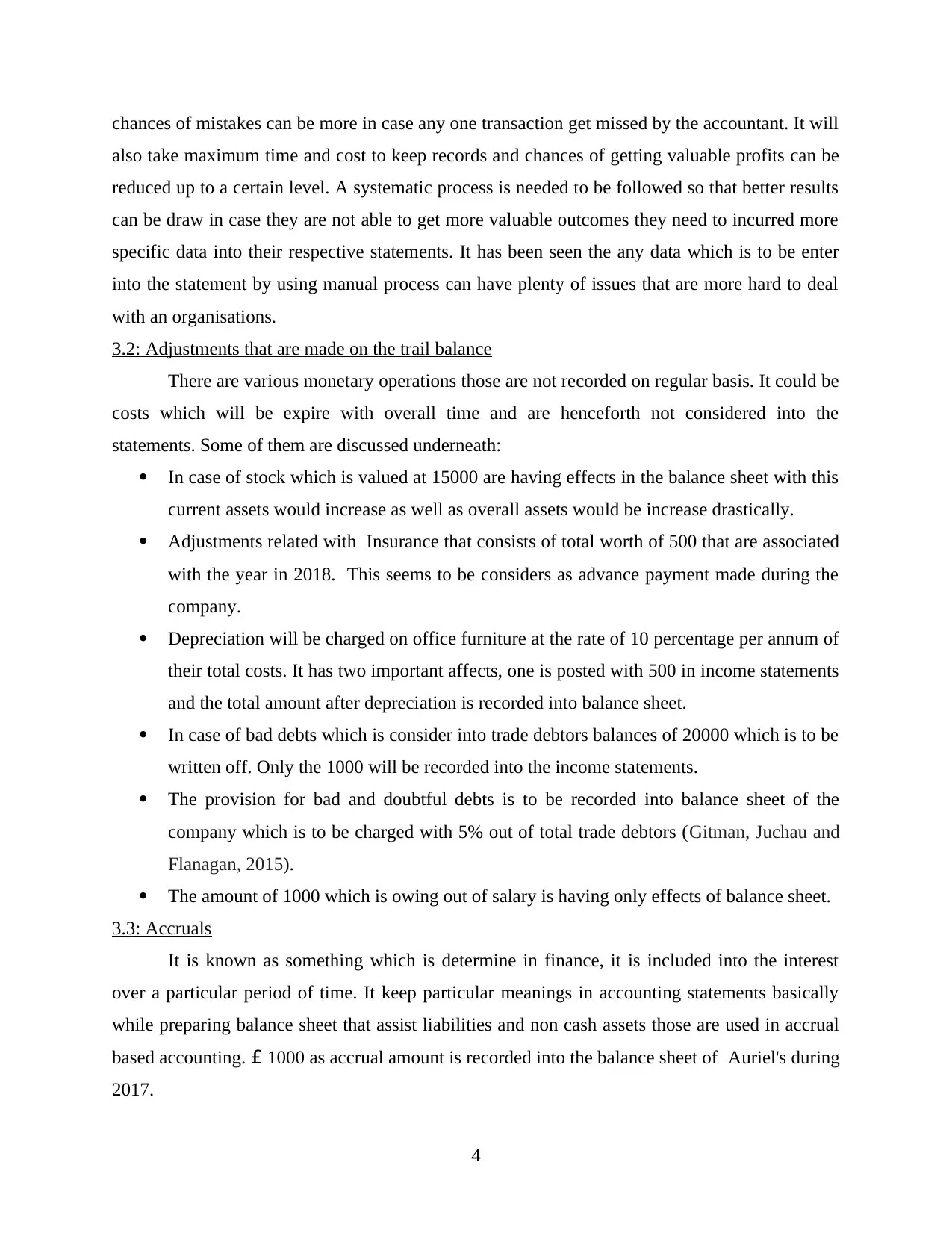
chances of mistakes can be more in case any one transaction get missed by the accountant. It will
also take maximum time and cost to keep records and chances of getting valuable profits can be
reduced up to a certain level. A systematic process is needed to be followed so that better results
can be draw in case they are not able to get more valuable outcomes they need to incurred more
specific data into their respective statements. It has been seen the any data which is to be enter
into the statement by using manual process can have plenty of issues that are more hard to deal
with an organisations.
3.2: Adjustments that are made on the trail balance
There are various monetary operations those are not recorded on regular basis. It could be
costs which will be expire with overall time and are henceforth not considered into the
statements. Some of them are discussed underneath:
In case of stock which is valued at 15000 are having effects in the balance sheet with this
current assets would increase as well as overall assets would be increase drastically.
Adjustments related with Insurance that consists of total worth of 500 that are associated
with the year in 2018. This seems to be considers as advance payment made during the
company.
Depreciation will be charged on office furniture at the rate of 10 percentage per annum of
their total costs. It has two important affects, one is posted with 500 in income statements
and the total amount after depreciation is recorded into balance sheet.
In case of bad debts which is consider into trade debtors balances of 20000 which is to be
written off. Only the 1000 will be recorded into the income statements.
The provision for bad and doubtful debts is to be recorded into balance sheet of the
company which is to be charged with 5% out of total trade debtors (Gitman, Juchau and
Flanagan, 2015).
The amount of 1000 which is owing out of salary is having only effects of balance sheet.
3.3: Accruals
It is known as something which is determine in finance, it is included into the interest
over a particular period of time. It keep particular meanings in accounting statements basically
while preparing balance sheet that assist liabilities and non cash assets those are used in accrual
based accounting. £ 1000 as accrual amount is recorded into the balance sheet of Auriel's during
2017.
4
also take maximum time and cost to keep records and chances of getting valuable profits can be
reduced up to a certain level. A systematic process is needed to be followed so that better results
can be draw in case they are not able to get more valuable outcomes they need to incurred more
specific data into their respective statements. It has been seen the any data which is to be enter
into the statement by using manual process can have plenty of issues that are more hard to deal
with an organisations.
3.2: Adjustments that are made on the trail balance
There are various monetary operations those are not recorded on regular basis. It could be
costs which will be expire with overall time and are henceforth not considered into the
statements. Some of them are discussed underneath:
In case of stock which is valued at 15000 are having effects in the balance sheet with this
current assets would increase as well as overall assets would be increase drastically.
Adjustments related with Insurance that consists of total worth of 500 that are associated
with the year in 2018. This seems to be considers as advance payment made during the
company.
Depreciation will be charged on office furniture at the rate of 10 percentage per annum of
their total costs. It has two important affects, one is posted with 500 in income statements
and the total amount after depreciation is recorded into balance sheet.
In case of bad debts which is consider into trade debtors balances of 20000 which is to be
written off. Only the 1000 will be recorded into the income statements.
The provision for bad and doubtful debts is to be recorded into balance sheet of the
company which is to be charged with 5% out of total trade debtors (Gitman, Juchau and
Flanagan, 2015).
The amount of 1000 which is owing out of salary is having only effects of balance sheet.
3.3: Accruals
It is known as something which is determine in finance, it is included into the interest
over a particular period of time. It keep particular meanings in accounting statements basically
while preparing balance sheet that assist liabilities and non cash assets those are used in accrual
based accounting. £ 1000 as accrual amount is recorded into the balance sheet of Auriel's during
2017.
4
⊘ This is a preview!⊘
Do you want full access?
Subscribe today to unlock all pages.

Trusted by 1+ million students worldwide
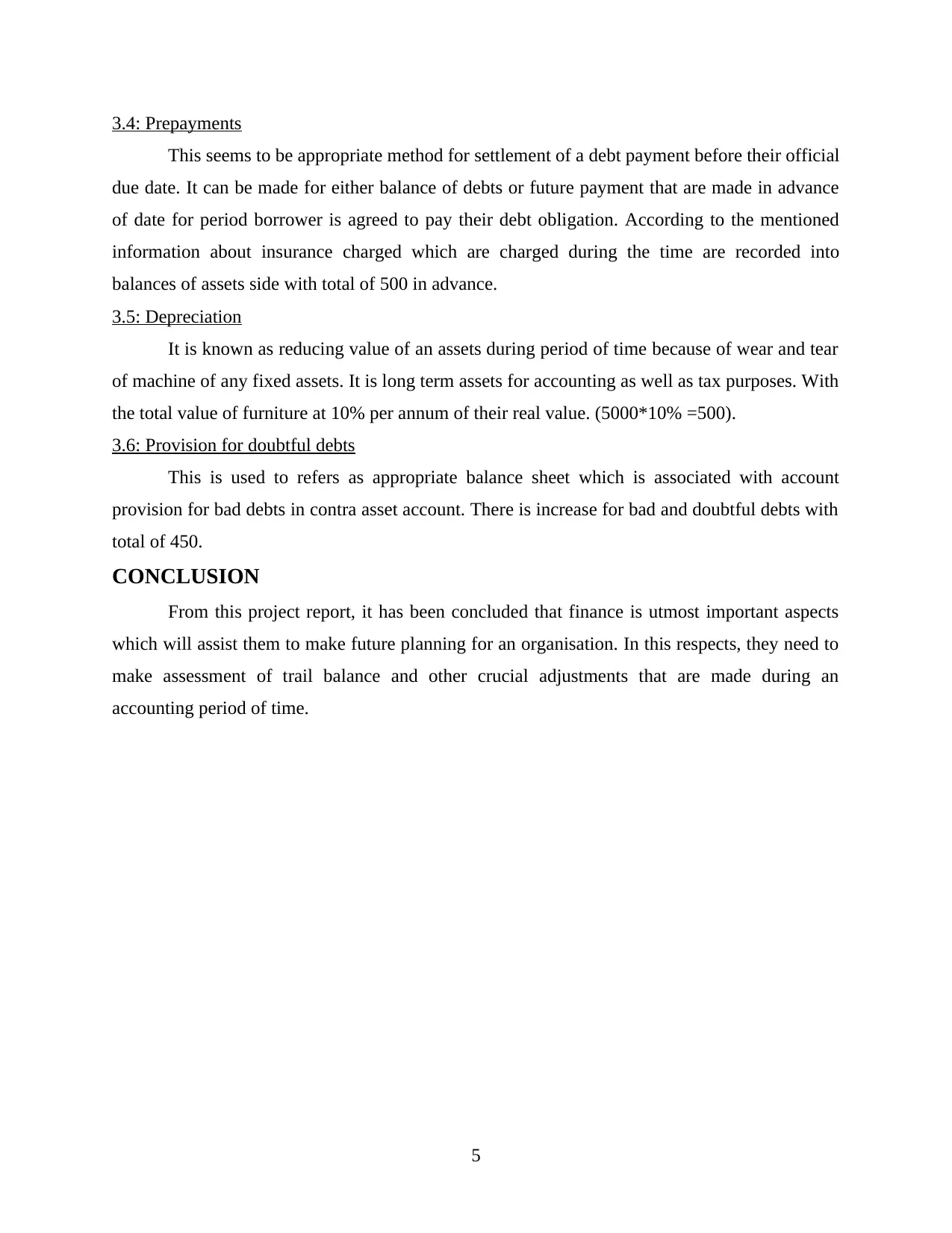
3.4: Prepayments
This seems to be appropriate method for settlement of a debt payment before their official
due date. It can be made for either balance of debts or future payment that are made in advance
of date for period borrower is agreed to pay their debt obligation. According to the mentioned
information about insurance charged which are charged during the time are recorded into
balances of assets side with total of 500 in advance.
3.5: Depreciation
It is known as reducing value of an assets during period of time because of wear and tear
of machine of any fixed assets. It is long term assets for accounting as well as tax purposes. With
the total value of furniture at 10% per annum of their real value. (5000*10% =500).
3.6: Provision for doubtful debts
This is used to refers as appropriate balance sheet which is associated with account
provision for bad debts in contra asset account. There is increase for bad and doubtful debts with
total of 450.
CONCLUSION
From this project report, it has been concluded that finance is utmost important aspects
which will assist them to make future planning for an organisation. In this respects, they need to
make assessment of trail balance and other crucial adjustments that are made during an
accounting period of time.
5
This seems to be appropriate method for settlement of a debt payment before their official
due date. It can be made for either balance of debts or future payment that are made in advance
of date for period borrower is agreed to pay their debt obligation. According to the mentioned
information about insurance charged which are charged during the time are recorded into
balances of assets side with total of 500 in advance.
3.5: Depreciation
It is known as reducing value of an assets during period of time because of wear and tear
of machine of any fixed assets. It is long term assets for accounting as well as tax purposes. With
the total value of furniture at 10% per annum of their real value. (5000*10% =500).
3.6: Provision for doubtful debts
This is used to refers as appropriate balance sheet which is associated with account
provision for bad debts in contra asset account. There is increase for bad and doubtful debts with
total of 450.
CONCLUSION
From this project report, it has been concluded that finance is utmost important aspects
which will assist them to make future planning for an organisation. In this respects, they need to
make assessment of trail balance and other crucial adjustments that are made during an
accounting period of time.
5
Paraphrase This Document
Need a fresh take? Get an instant paraphrase of this document with our AI Paraphraser
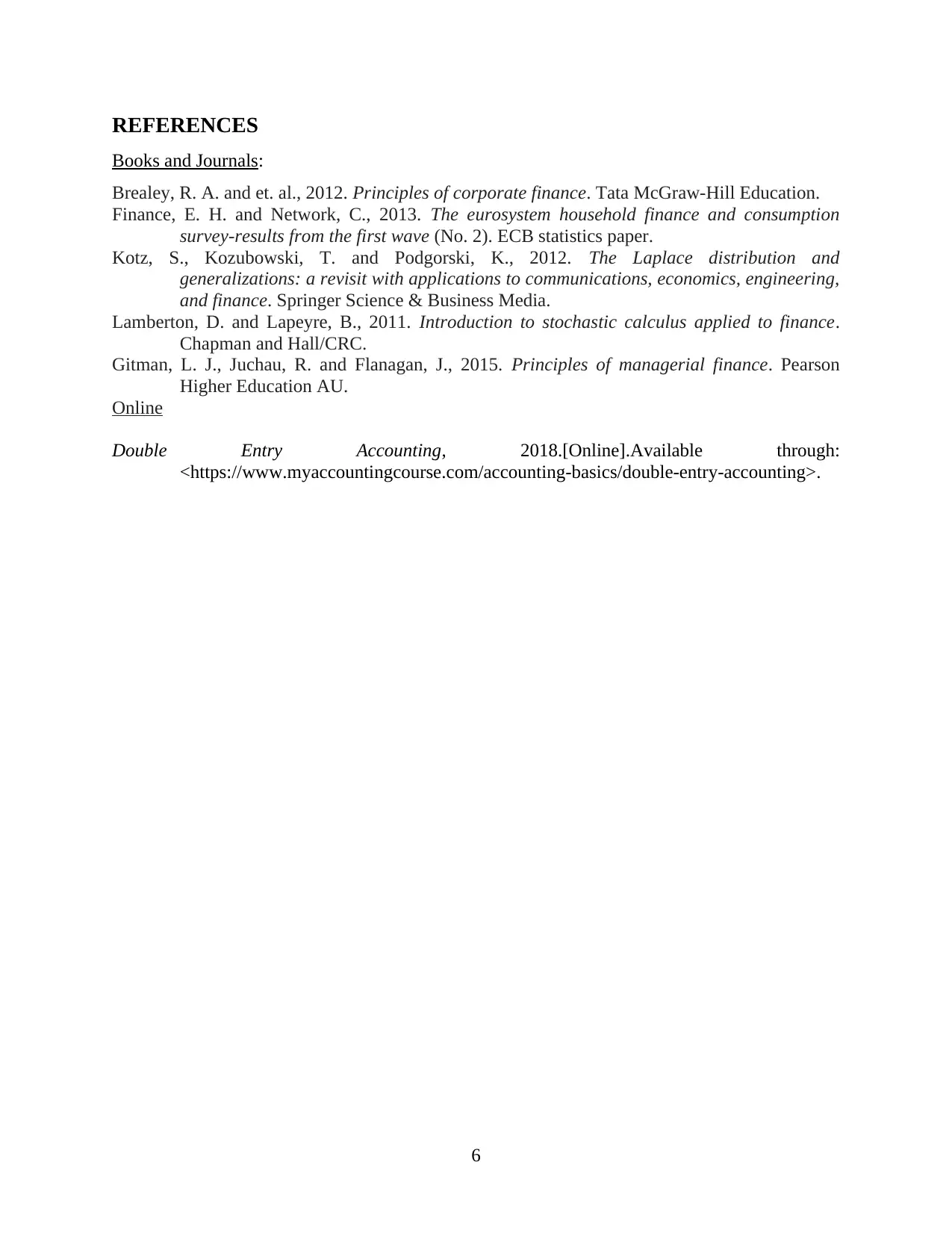
REFERENCES
Books and Journals:
Brealey, R. A. and et. al., 2012. Principles of corporate finance. Tata McGraw-Hill Education.
Finance, E. H. and Network, C., 2013. The eurosystem household finance and consumption
survey-results from the first wave (No. 2). ECB statistics paper.
Kotz, S., Kozubowski, T. and Podgorski, K., 2012. The Laplace distribution and
generalizations: a revisit with applications to communications, economics, engineering,
and finance. Springer Science & Business Media.
Lamberton, D. and Lapeyre, B., 2011. Introduction to stochastic calculus applied to finance.
Chapman and Hall/CRC.
Gitman, L. J., Juchau, R. and Flanagan, J., 2015. Principles of managerial finance. Pearson
Higher Education AU.
Online
Double Entry Accounting, 2018.[Online].Available through:
<https://www.myaccountingcourse.com/accounting-basics/double-entry-accounting>.
6
Books and Journals:
Brealey, R. A. and et. al., 2012. Principles of corporate finance. Tata McGraw-Hill Education.
Finance, E. H. and Network, C., 2013. The eurosystem household finance and consumption
survey-results from the first wave (No. 2). ECB statistics paper.
Kotz, S., Kozubowski, T. and Podgorski, K., 2012. The Laplace distribution and
generalizations: a revisit with applications to communications, economics, engineering,
and finance. Springer Science & Business Media.
Lamberton, D. and Lapeyre, B., 2011. Introduction to stochastic calculus applied to finance.
Chapman and Hall/CRC.
Gitman, L. J., Juchau, R. and Flanagan, J., 2015. Principles of managerial finance. Pearson
Higher Education AU.
Online
Double Entry Accounting, 2018.[Online].Available through:
<https://www.myaccountingcourse.com/accounting-basics/double-entry-accounting>.
6
1 out of 8
Related Documents
Your All-in-One AI-Powered Toolkit for Academic Success.
+13062052269
info@desklib.com
Available 24*7 on WhatsApp / Email
![[object Object]](/_next/static/media/star-bottom.7253800d.svg)
Unlock your academic potential
Copyright © 2020–2025 A2Z Services. All Rights Reserved. Developed and managed by ZUCOL.





